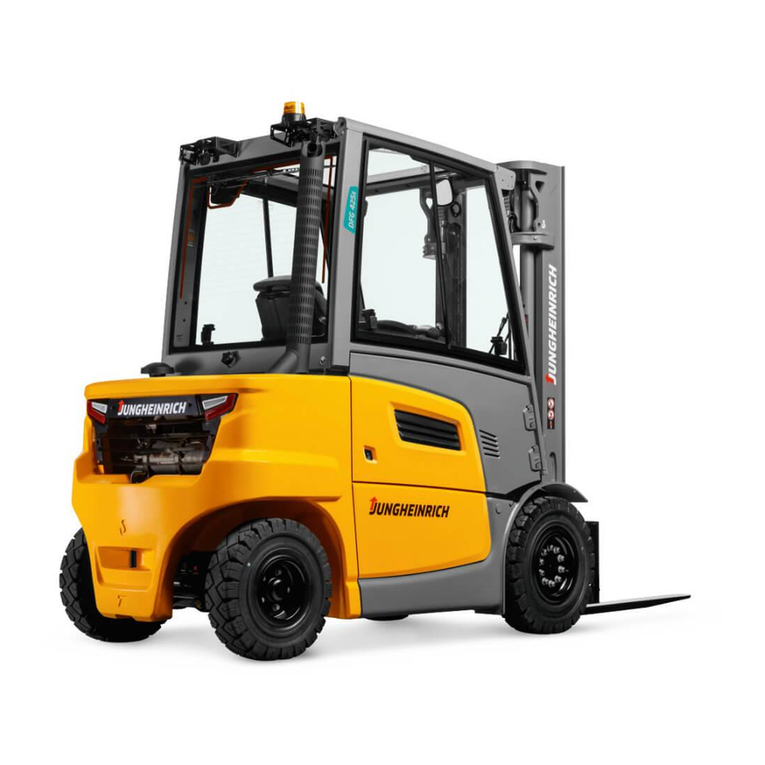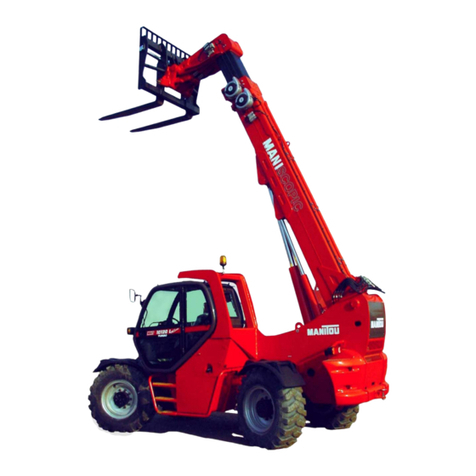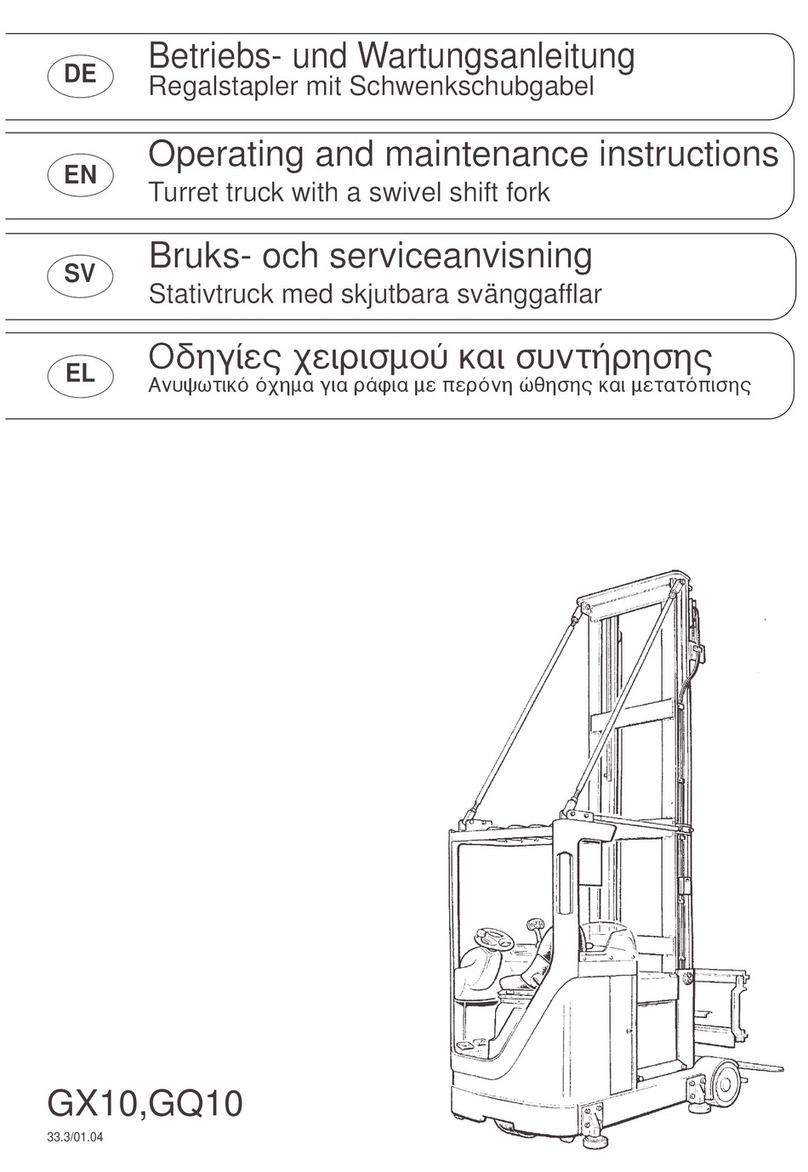Festo Robotino 8029453 Parts list manual

Festo Didactic
8030737 de/en
09/2013
(Abbildung ähnlich/similar illustration)
802945
3
Forklift
Robotino
®
Kurzbeschreibung
Brief description

Order No.: 8030737
Edition: 09/2013
Editor: Frank Ebel, Mustafa Ersoy
Layout: 01/2014, Frank Ebel
© Festo Didactic SE, Rechbergstraße 3, 73770 Denkendorf, Germany, 2015
+49 711 3467-0 www.festo-didactic.com
The copying, distribution and utilization of this document as well as the communication of its contents to
others without expressed authorization is prohibited. Offenders will be held liable for the payment of
damages. All rights reserved, in particular the right to carry out patent, utility model or ornamental design
registration.

© Festo Didactic 8030737 3
Inhalt
1 Bestimmungsgemäße Verwendung ___________________________________________________ 4
2 Für Ihre Sicherheit __________________________________________________________________5
3 Gabelstapler_______________________________________________________________________6
3.1 Funktion __________________________________________________________________________6
3.2 Mechanischer Anbau ________________________________________________________________7
3.3 Elektrischer Anschluss _______________________________________________________________8
3.4 Sicherheitshinweise _________________________________________________________________9
3.5 Optionale Montage__________________________________________________________________9
Table of contents
1 Use for intended purpose __________________________________________________________ 11
2 For your safety ___________________________________________________________________ 12
3 Forklift__________________________________________________________________________ 13
3.1 Function_________________________________________________________________________ 13
3.2 Mechanical design ________________________________________________________________ 14
3.3 Electrical connection_______________________________________________________________ 15
3.4 Safety instructions ________________________________________________________________ 16
3.5 Optional assembly ________________________________________________________________ 16

4© Festo Didactic 8030737
1Bestimmungsgemäße Verwendung
Das Modul ist nur zu benutzen:
•für die bestimmungsgemäße Verwendung im Lehr- und Ausbildungsbetrieb
•in sicherheitstechnisch einwandfreiem Zustand
Die Module sind nach dem heutigen Stand der Technik und den anerkannten sicherheitstechnischen Regeln
gebaut. Dennoch können bei unsachgemäßer Verwendung Gefahren für Leib und Leben des Benutzers oder
Dritter und Beeinträchtigungen der Komponenten entstehen.
Das Lernsystem von Festo Didactic ist ausschließlich für die Aus- und Weiterbildung im Bereich
Automatisierung und Technik entwickelt und hergestellt. Das Ausbildungsunternehmen und/oder die
Ausbildenden hat/haben dafür Sorge zu tragen, dass die Auszubildenden die Sicherheitsvorkehrungen, die
in diesem Arbeitsbuch beschrieben sind, beachten.
Festo Didactic schließt hiermit jegliche Haftung für Schäden des Auszubildenden, des
Ausbildungsunternehmens und/oder sonstiger Dritter aus, die bei Gebrauch/Einsatz dieses Gerätes
außerhalb einer reinen Ausbildungssituation auftreten; es sei denn Festo Didactic hat solche Schäden
vorsätzlich oder grob fahrlässig verursacht.

© Festo Didactic 8030737 5
2Für Ihre Sicherheit
Allgemein
•Die Auszubildenden dürfen nur unter Aufsicht einer Ausbilderin/eines Ausbilders an dem mobilen
Robotersystem Robotino®arbeiten.
•Beachten Sie die Angaben der Datenblätter zu den einzelnen Elementen, insbesondere auch alle
Hinweise zur Sicherheit.
•Verpacken Sie Robotino®ausschließlich im vollständig ausgeschalteten Zustand.
Elektrik
•Herstellen bzw. abbauen von elektrischen Verbindungen nur in spannungslosem Zustand.
•Verwenden Sie nur Kleinspannungen, maximal 24 V DC.
•Erden Sie das Robotino®Gehäuse („Kommandobrücke“), bevor Sie es öffnen. Gehäuse abnehmen, keine
elektrischen Bauteile berühren Elektrostatische Entladung beachten (engl. electrostatic discharge,
kurz ESD).
•Setzen Sie die Kommandobrücke immer senkrecht auf, um den hochstehenden Steckkontakt nicht zu
beschädigen.
•Änderungen an der Verkabelung oder Umbauten in der Kommandobrücke auf eigene Gefahr unter
Verlust der Garantie. Verwenden Sie ausschließlich Original Ersatzteile.
•Nach dem Laden Ladegerät von Robotino®trennen. Sollte das Ladegerät von Netz getrennt werden,
jedoch mit Robotino®verbunden bleiben können die Akkus über das Ladegerät entladen/zerstört
werden.
Mechanik
•Transportieren Sie den Robotino®, indem sie Ihn an den Haltegriffen tragen.
•Montieren Sie alle Komponenten fest auf dem Chassis oder den vorgesehenen
Befestigungsvorrichtungen.
•Greifen Sie nur bei Stillstand in das Robotersystem.
•Fassen Sie nie an die Räder von Robotino®! Je nach Programm könnten die Räder plötzlich zu drehen
anfangen. Um den Widerstand am Rad zu erhöhen Robotino®auf den Boden drücken (z. B. bei Übungen
zum Thema PID-Controller).
•Robotino®besteht aus einer präzisen lasergeschnittenen und -geschweißten Edelstahlkonstruktion.
Achten Sie bei Arbeiten mit Robotino®auf evtl. scharfe Kanten (Kabeldurchführung, mechanische
Montage/Demontage).

6© Festo Didactic 8030737
3Gabelstapler
3.1 Funktion
Mit dem Modul Gabelstapler agiert Robotino®wie ein konventionelles Förderfahrzeug. Der Motor des
Gabelstaplers wird an den 4. Motoranschluss von Robotino®angeschlossen. Es sind 2 Endlagensensoren
und eine Schaltfahne angebracht, um dem maximalen Arbeitsbereich zu definieren. Die Endlagen sind nur
softwaretechnisch realisiert.
Mit Hilfe von Robotino®View können Sie die Achse innerhalb des Arbeitsbereichs bewegen und mit
unterschiedlichen Geschwindigkeiten verfahren.
Um in Robotino®View Positionen des Gabelstaplers zu speichern, gehen Sie folgendermaßen vor:
•Fahren Sie die Aufnahme auf den niedrigsten Punkt.
•Setzen Sie den Positionswert des Funktionsbausteins Drehgebereingangs auf 0.
•Fahren Sie mit Robotino®View den Gabelstapler in die gewünschte Position. Verwenden Sie hierzu den
Funktionsbaustein Leistungsausgang.
•Tragen Sie sich den aktuellen Positionswert des Drehgebers in einer Konstante ein, um später einen
Soll-Ist-Vergleich durchzuführen.
•Sie können auch inkrementell verfahren, wenn Sie die Ist-Position nach jedem Verfahren auf 0
zurücksetzen.
Bitte beachten Sie immer, dass Sie die Endlagen der Linearachse in Ihrem Robotino® View Programm
beachten.

Gabelstapler
© Festo Didactic 8030737 7
3.2 Mechanischer Anbau
Hinweis
Falls Sie optische Sensoren einbauen wollen, sollten Sie diese zuerst montieren.
–Montieren Sie das Modul an die vier markierten Gewinde der Adapterplatte
–Setzen Sie das Modul in die Ladebucht des Robotino®.
–Befestigen Sie das Modul an beiden Seitendes Robotino®mit den vier M4x10 Schrauben, von außen
nach innen (1).

Gabelstapler
8© Festo Didactic 8030737
3.3 Elektrischer Anschluss
–Schließen Sie die Leitungen, für digitale und analoge Signale, des Gabelstaplers an die E/A-Schnittstelle
(1) an der Kommandobrücke an.
–Die Leitungen vom Motor werden in der Ladebucht, Inkrementalgeber links (2) und die
Spannungsversorgung rechts (3), von Robotino®angeschlossen.
Der optische Sensor wird wie folgt angeschlossen:
•Braun +24V
•Blau GND
•Schwarz digitaler Eingang
•Weiß analoger Eingang
Die induktiven Sensoren werden wie folgt angeschlossen:
•Braun +24V
•Blau GND
•Schwarz digitaler Eingang
•Weiß n.c.

Gabelstapler
© Festo Didactic 8030737 9
3.4 Sicherheitshinweise
•Bitte beachten Sie, dass die Endschalter den Antrieb nicht hart abschalten. Die Endlagen der
Linearachse sind nur über die Software realisiert.
•Arbeiten Sie nicht am Gabelstapler, während der sich in Betrieb befindet. Sie können sich die Finger
einklemmen.
3.5 Optionale Montage
Der Robotino®bietet, durch eine Erweiterung mit Säule und Segmenten, die Möglichkeit, die Module auf
verschiedene Ebenen und Positionen zu montieren. Hierfür muss die Adapterplatte (1) mit den
Montagewinkeln (2) versehen und in die L-förmigen Montageöffnungen (3) eingesteckt und verschraubt
werden.
Wenn nun das Modul an den hier markierten Bohrungen befestigt wird, hat es die passende Höhe und
Position, um direkt mit einer MPS®-Station zu agieren.

Gabelstapler
10 © Festo Didactic 8030737

© Festo Didactic 8030737 11
1Use for intended purpose
The module may only be used:
•For its intended purpose in teaching and training applications
•When its safety functions are in flawless condition
The modules are designed in accordance with the latest technology, as well as recognised safety rules.
However, life and limb of the user and third parties may be endangered, and the components may be
impaired, if they are used improperly.
The training system from Festo Didactic has been developed and manufactured exclusively for training and
vocational education in the fields of automation and technology. The respective training companies and/or
trainers must ensure that all trainees observe the safety precautions which are described in this workbook.
Festo Didactic hereby excludes any and all liability for damages suffered by trainees, the training company
and/or any third parties, which occur during use of the equipment set in situations which serve any purpose
other than training and/or vocational education, unless such damages have been caused by Festo Didactic
due to malicious intent or gross negligence.

12 © Festo Didactic 8030737
2For your safety
General
•Trainees must only work on the Robotino®under the supervision of an instructor.
•Observe the data in the data sheets for the individual components, in particular all notes on safety!
•The Robotino®may only be packed in the fully switched-off state.
Electrics
•Electrical connections are to be wired up or disconnected only when power is disconnected!
•Use only low voltages of up to 24 V DC.
•Earth the Robotino®housing (“command bridge”) before opening it. Remove the housing without
touching any electrical components watch out for electrostatic discharge.
•Always position the command bridge vertically so as not to damage the raised pin contact.
•Modifications to the wiring or conversions in the command bridge are carried out at your own risk and
nullify the warranty. Only use genuine spare parts.
•Disconnect charger from Robotino®after charging. If the charger is disconnected from the mains but left
connected to Robotino®, it can discharge/damage the batteries.
Mechanics
•Move the Robotino®only by carefully seizing it by its handles.
•Securely mount all components on the chassis.
•No manual intervention unless the Robotino®is at rest.
•Never touch the wheels on Robotino®! Depending on the program, the wheels could suddenly start
turning. To increase the resistance at the wheel, press Robotino®into the floor (e.g. for exercises on the
PID controller).
•Robotino®features a precision laser-cut and laser-welded stainless steel design; Watch out for sharp
edges when working with it (cable routing, mechanical assembly/disassembly).

© Festo Didactic 8030737 13
3Forklift
3.1 Function
When equipped with the forklift module, the Robotino®functions like a conventional conveyor vehicle. The
forklift’s motor is connected to the fourth motor terminal at the Robotino®. 2 limit switches and a switch lug
are attached in order to specify the maximum working range. The end positions are implemented by means
of software only.
With the help of Robotino®View, you can move the axis within its working range and travel at different
speeds.
Proceed as follows in order to save the forklift positions to memory in Robotino®View:
–Move the forks to the lowest possible point.
–Set the position value to 0 at the rotary encoder input function block.
–Advance the forklift to the desired position with the help of Robotino®View. Use the power output
function block to this end.
–Enter the rotary encoder’s current position value as a constant in order to be able to conduct a target-
actual comparison later on.
–Incremental travel is also possible if the actual position is reset to 0 after each travel operation.
Be sure to observe the end positions of the linear axis in the Robotino®View program.

Forklift
14 © Festo Didactic 8030737
3.2 Mechanical design
Note
If you want to install opto-electric sensors, this should be done first.
–Mount the module on the four threads identified on the adapter plate.
–Place the module into the Robotino®loading bay.
–Secure the module at both sides of the Robotino®with the four M4x10 screws, inserted from the
outside in (1).

Forklift
© Festo Didactic 8030737 15
3.3 Electrical connection
–Connect the forklift’s cables for digital and analogue signals to the I/O interface (1) on the command
bridge.
–The cables from the motor are connected in Robotino’s®loading bay – incremental encoder: left (2) and
power supply: right (3).
The opto-electric sensor is connected as follows:
–Brown: + 24 V
–Blue: GND
–Black: digital input
–White: analogue input
The inductive sensors are connected as follows:
–Brown: + 24 V
–Blue: GND
–Black: digital input
–White: n.c.

Forklift
16 © Festo Didactic 8030737
3.4 Safety instructions
•Please note that the limit switches do not shut down the drive abruptly. The end positions of the linear
axis are implemented via the software only.
•Do not work on the forklift while it is in operation. Your fingers might otherwise get caught in the
mechanism.
3.5 Optional assembly
An expansion consisting of a mounting column and a mounting platform provides Robotino®users with the
opportunity of mounting the modules at different levels and positions. To do this, the adapter plate (1) must
be attached to the mounting bracket (2) and inserted into the L-shaped mounting holes (3) and secured with
screws.
If the module is mounted on the drill holes identified, it’s positioned correctly for direct interaction with an
MPS®station.




Festo Didactic SE
Rechbergstraße 3
73770 Denkendorf
Germany
+49 711 3467-0 www.festo-didactic.com
Table of contents
Languages:
Popular Forklift manuals by other brands
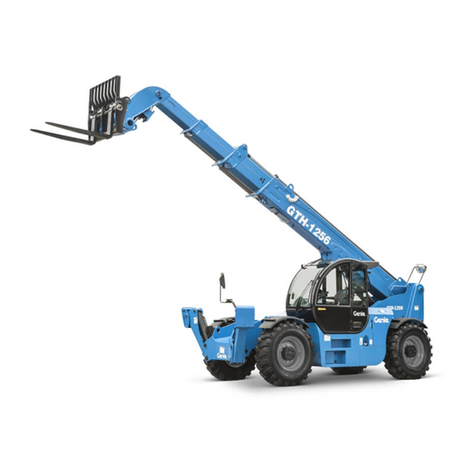
Genie
Genie GTH-1256 Operator's manual

Lifter
Lifter GS S2-S4 Use and maintenance manual
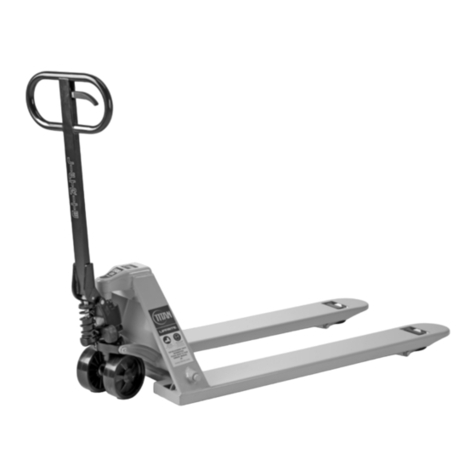
Lift-Rite
Lift-Rite Titan LCM50 Owner's manual operating instruction & parts list
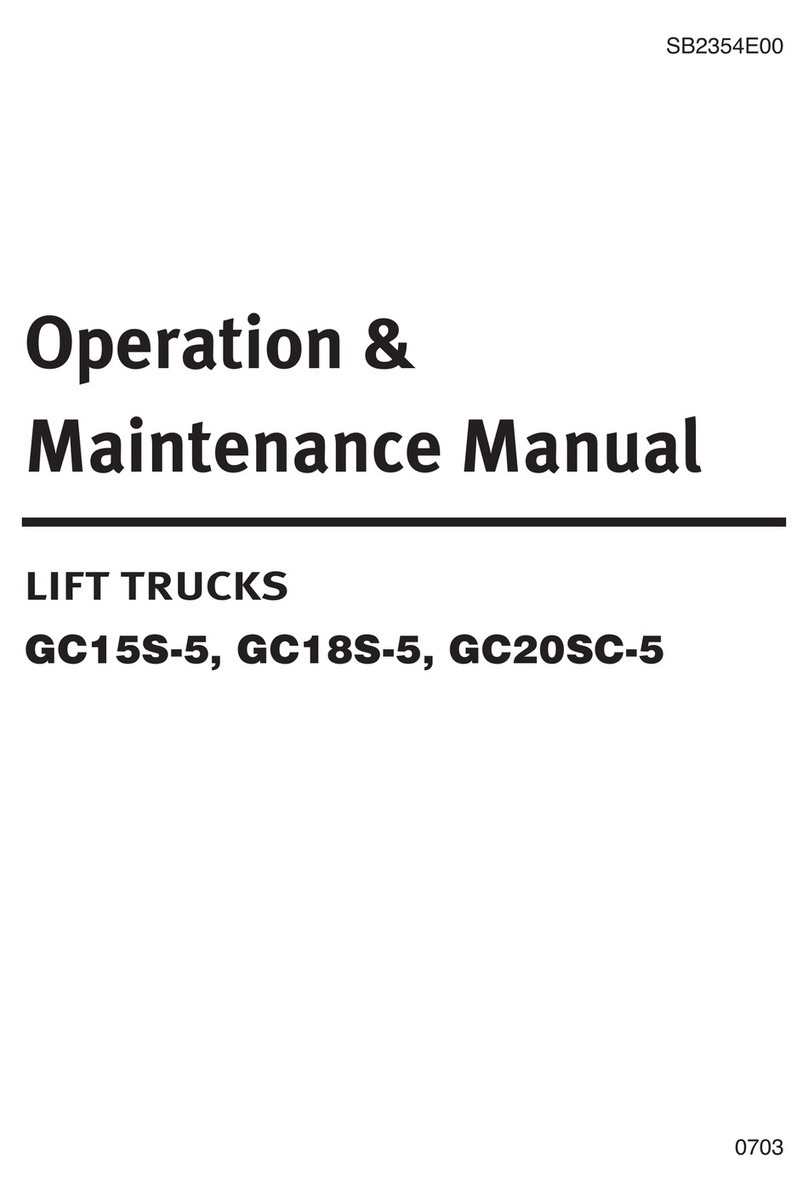
Doosan
Doosan GC15S-5 Operation & maintenance manual

Noblelift
Noblelift PS35/44 Instruction handbook
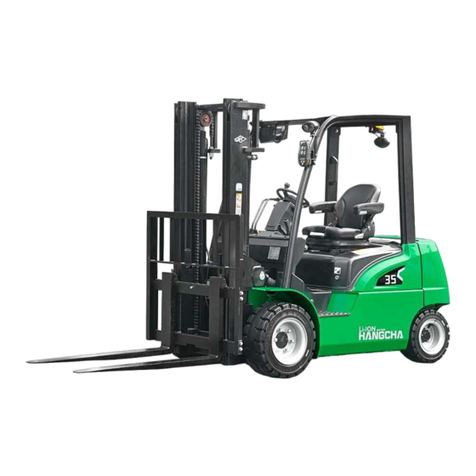
HANGCHA
HANGCHA XC Series Operation and maintenance manual

Jungheinrich
Jungheinrich DFG 316 operating instructions

SWEDMACH
SWEDMACH Liftwell 22 Instruction manual & Spare parts catalogue
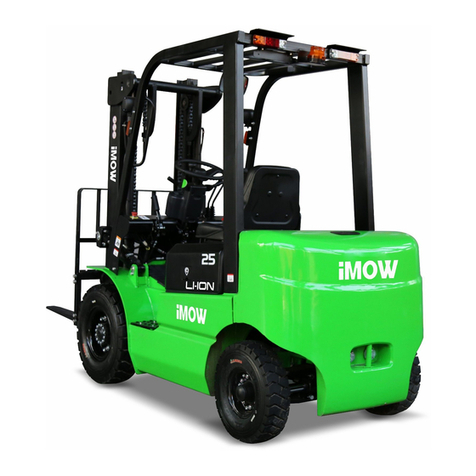
EP Equipment
EP Equipment IMOW ICE251 Operation manual
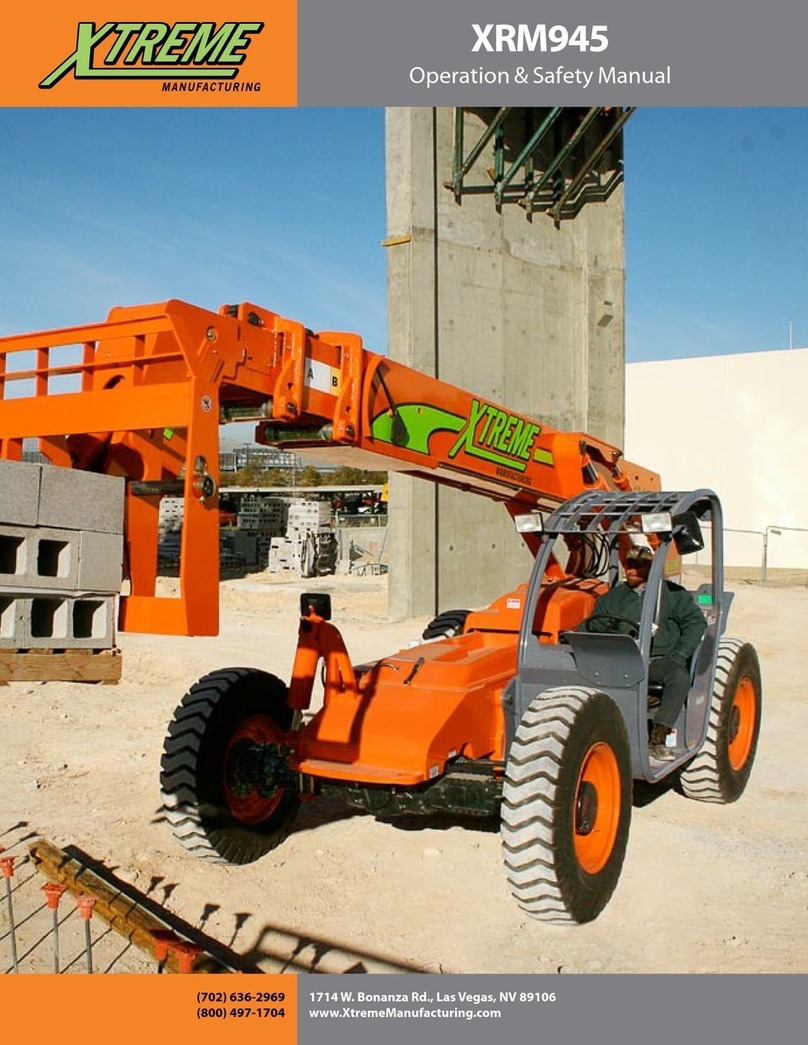
Xtreme Manufacturing
Xtreme Manufacturing XRM945 Operation & safety manual

BYD
BYD PMW20 Service manual

albutt
albutt FORGED TINE Series INSTRUCTION MANUAL AND PARTS CATALOGUE
